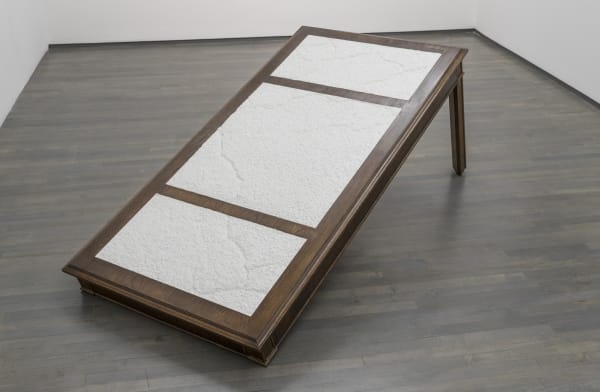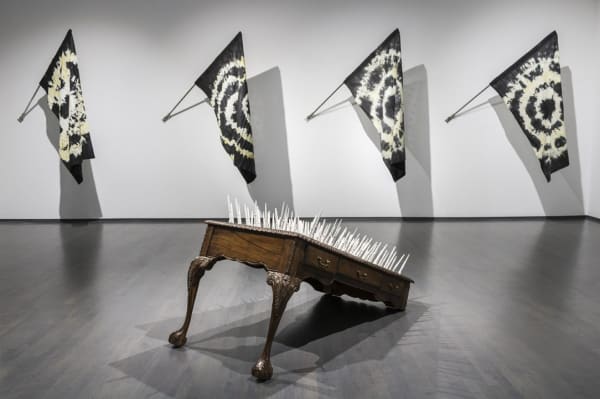Kavi Gupta is pleased to present Sign, a solo exhibition of original work by Glenn Kaino.
Throughout his practice, Kaino has rigorously investigated the expansive reach of colonialism and power to inspire new questions about the nature of humanity and the implications of our actions on our world and on others. Deconstructing historical events and probing the ambitions of man for future conquest, Kaino prompts a complex dialog about the potential for change in our time. With this new exhibition, Sign, Kaino directly challenges the signifiers of colonial action: objects which encode the terms of traversal, demarcate ownership, and crystallize territory into the social contract. Maps, flags, signs, and peace agreements all have one thing in common, they are symbolic markers of man’s assertion of his ownership of his world. In Kaino’s most recent provocation, things are not that simple; each of these identifiers are not as static as they would seem, rather they are living objects that themselves perform back to the viewer in response to their environment.
At the heart of the exhibition are two sculptures created from tables that are missing a pair of legs. These amputee desks are inert in their static state, unable to provide a level work surface for usage and are designed to be activated by a performer. Drawing from a rigorous process of collecting photographs and paintings of important historical treaties, Kaino began by creating a meticulous analysis of the aesthetics of document signing in times of compromise. Each desktop in this series of work is adorned in regalia signaling a different kind of document—a surrender, an armistice, a peace treaty, a covenant—and have been given the titles of theoretical contracts that propose hypothetical future scenarios in which the tables might be needed. They exist as absurd objects, a conceptual tool for use in an imagined future.
Kaino’s flag series began with pure white recreations of the American flag, that were tie-dye soaked with a Civil War-era tarring solution. Simply left alone, the fabric heats up as the oxidation of the chemicals creates an exothermic reaction. This spontaneous combustion appears as a symbolic representation of the volatile nature of this time of crisis. The resulting pattern is a beautifully poignant image of concentric circles, a target, alternating black, tan and white. Under the light of examination, the shadows that the flags cast represent the American flag as clear and pristine as a new flag might—a poetic reminder that even during our most unstable and explosive time, the ideals that exist within our concept of our country might still be preserved.
Viewers are simultaneously insiders and outsiders in the series of neon works depicting variations of texts commonly associated with property signs. Inspired by the urgent dialog about who owns the right to tell stories of marginality, these artworks suggest that the answers are not always the same, that context and expression matter. The signs are hung so the text reads backwards from the wall, positioning the viewer behind the sign and inside the territory that the sign is meant to defend ownership of—a traditional unfamiliar and uncomfortable position for an agent of postcolonial thought operating from the margins. This gesture of complicity is unshakable, there is no room or way to be back on the outside of the sign. However, should the viewer take a selfie, the text is magically reversed and the viewer seemingly is positioned externally in relationship to the text. The very action of a selfie—one’s desire to express a position in a social environment—reverses the polarity of the dialog and repositions the viewer to the outside for the public to see, while in the space of the lived experience, they are inside.
The final series of works in the exhibition are further explorations of border, mapping, and the epistemic control of colonialism. Beginning with a series of maps that express the territorial boundaries won in the combative struggle for colonial expansion, Kaino first calls attention to the violence hidden in the cartographic translation by distressing the graphical elements with a forceful transfer technique. Kaino’s thick and abstracted marks distort and obliterate the fine penmanship used to delicately present the results of violent collisions that took place in the actual physical space that the maps represent.
These ideas are further complicated by the shaping of new diagrams into circular forms presented on the backdrop of ink stained wood. The maps appear at viewing distance to be illustrations of planets, an indictment of our future interstellar colonial ambition, played out in our past. The frames of these works are made in unsealed copper, which further records the hands of the artist, handlers, patrons and any audience member who touches the work. The borders are themselves each a boundary for an idea that becomes an endless record of complicity and implication.
Glenn Kaino is a Los Angeles based conceptual artist known globally for his complex project-based multidisciplinary work that utilizes art to create spaces of translation between conflicting ideologies, opposing systems, and strict dichotomies in material and experiential ways. Kaino’s practice is a unique facility that connects diverse bodies of knowledge, working collaboratively with activists, scientists, linguists, magicians, and experts from numerous other fields, in order to build new relationships between seemingly disparate areas of research and their application in symbolic and tangible form.
Recent exhibitions include FOCUS at Modern Art Museum of Forth Worth, Forth Worth, TX (2016); Tank at Grand Arts, Kansas City, MO (2015); The 5×5 Project in Washington DC (2014); Prospect.3: Notes for Now in New Orleans, LA (2014); The Lyon Biennale in Lyon, France (2013); the US Pavilion at The Cairo Biennale in Cairo, Egypt (2013); and The Whitney Biennial in New York, NY (2004). Upcoming shows include the Contemporary Arts Center, Cincinnati, OH (November 2017) and the Massachusetts Museum of Contemporary Art, North Adams, MA (2020). Kaino is currently producing a feature length documentary on activist and athlete Tommie Smith, set for a 2018 premiere.
-
 Glenn KainoSign, A Pen for Every Player, 2017Wood, plaster, metal33 x 55 x 30 in
Glenn KainoSign, A Pen for Every Player, 2017Wood, plaster, metal33 x 55 x 30 in
83.8 x 139.7 x 76.2 cm -
 Glenn KainoSign, Connected Terrain, 2017Wood, plaster36 x 72 x 28 1/2 in
Glenn KainoSign, Connected Terrain, 2017Wood, plaster36 x 72 x 28 1/2 in
91.4 x 182.9 x 72.4 cm -
 Glenn KainoThe Past Has Not Yet Happened (Algeria), 2017Archival ink transfer on calcium sulfate with steel reinforcement, wood and India ink on canvas panel with copper frame49 x 41 x 3 in
Glenn KainoThe Past Has Not Yet Happened (Algeria), 2017Archival ink transfer on calcium sulfate with steel reinforcement, wood and India ink on canvas panel with copper frame49 x 41 x 3 in
124.5 x 104.1 x 7.6 cm -
 Glenn KainoThe Past Has Not Yet Happened (Brazil), 2017Archival ink transfer on calcium sulfate with steel reinforcement, wood and India ink on canvas panel with copper frame49 x 41 x 3 in
Glenn KainoThe Past Has Not Yet Happened (Brazil), 2017Archival ink transfer on calcium sulfate with steel reinforcement, wood and India ink on canvas panel with copper frame49 x 41 x 3 in
124.5 x 104.1 x 7.6 cm -
 Glenn KainoThe Past Has Not Yet Happened (Egypt), 2017Archival ink transfer on calcium sulfate with steel reinforcement, wood and India ink on canvas panel with copper frame41 x 73 x 3 in
Glenn KainoThe Past Has Not Yet Happened (Egypt), 2017Archival ink transfer on calcium sulfate with steel reinforcement, wood and India ink on canvas panel with copper frame41 x 73 x 3 in
104.1 x 185.4 x 7.6 cm -
 Glenn KainoThe Past Has Not Yet Happened (India), 2017Archival ink transfer on calcium sulfate with steel reinforcement, wood and India ink on canvas panel with copper frame49 x 41 x 3 in
Glenn KainoThe Past Has Not Yet Happened (India), 2017Archival ink transfer on calcium sulfate with steel reinforcement, wood and India ink on canvas panel with copper frame49 x 41 x 3 in
124.5 x 104.1 x 7.6 cm -
 Glenn KainoThe Past Has Not Yet Happened (Panama), 2017Archival ink transfer on calcium sulfate with steel reinforcement, wood and India ink on canvas panel with copper frame45 x 41 x 3 in
Glenn KainoThe Past Has Not Yet Happened (Panama), 2017Archival ink transfer on calcium sulfate with steel reinforcement, wood and India ink on canvas panel with copper frame45 x 41 x 3 in
114.3 x 104.1 x 7.6 cm -
 Glenn KainoOrbital Attitude 10.82, 2017Archival ink transfer on calcium sulfate with steel reinforcement, wood and India ink on canvas panel with copper frame15 x 12 x 2 1/2 in
Glenn KainoOrbital Attitude 10.82, 2017Archival ink transfer on calcium sulfate with steel reinforcement, wood and India ink on canvas panel with copper frame15 x 12 x 2 1/2 in
38.1 x 30.5 x 6.3 cm -
 Glenn KainoOrbital Attitude 19.432, 2017Archival ink transfer on calcium sulfate with steel reinforcement, wood and India ink on canvas panel with copper frame15 x 12 x 2 1/2 in
Glenn KainoOrbital Attitude 19.432, 2017Archival ink transfer on calcium sulfate with steel reinforcement, wood and India ink on canvas panel with copper frame15 x 12 x 2 1/2 in
38.1 x 30.5 x 6.3 cm -
 Glenn KainoOrbital Attitude 21.5, 2017Archival ink transfer on calcium sulfate with steel reinforcement, wood and India ink on canvas panel with copper frame15 x 12 x 2 1/2 in
Glenn KainoOrbital Attitude 21.5, 2017Archival ink transfer on calcium sulfate with steel reinforcement, wood and India ink on canvas panel with copper frame15 x 12 x 2 1/2 in
38.1 x 30.5 x 6.3 cm -
 Glenn KainoOrbital Attitude 32.407, 2017Archival ink transfer on calcium sulfate with steel reinforcement, wood and India ink on canvas panel with copper frame15 x 12 x 2 1/2 in
Glenn KainoOrbital Attitude 32.407, 2017Archival ink transfer on calcium sulfate with steel reinforcement, wood and India ink on canvas panel with copper frame15 x 12 x 2 1/2 in
38.1 x 30.5 x 6.3 cm -
 Glenn KainoSpontaneous Combustion (02:49:09), 2017Cotton flags, tarring solution, time41 x 68 in
Glenn KainoSpontaneous Combustion (02:49:09), 2017Cotton flags, tarring solution, time41 x 68 in
104.1 x 172.7 cm -
 Glenn KainoRESTRICTED AREA, 2017NeonApprox 41 x 52 x 2 1/2 in
Glenn KainoRESTRICTED AREA, 2017NeonApprox 41 x 52 x 2 1/2 in
104.1 x 132.1 x 6.3 cm -
 Glenn KainoNO TRESPASSING, 2017NeonApprox 41 x 52 x 2 1/2 in
Glenn KainoNO TRESPASSING, 2017NeonApprox 41 x 52 x 2 1/2 in
104.1 x 132.1 x 6.3 cm



















